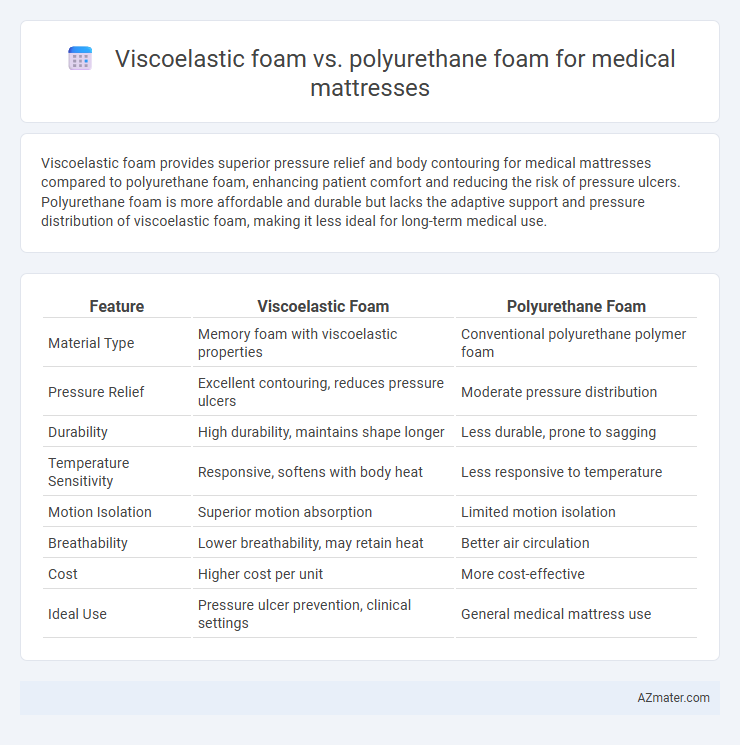Viscoelastic foam provides superior pressure relief and body contouring for medical mattresses compared to polyurethane foam, enhancing patient comfort and reducing the risk of pressure ulcers. Polyurethane foam is more affordable and durable but lacks the adaptive support and pressure distribution of viscoelastic foam, making it less ideal for long-term medical use.
Table of Comparison
| Feature | Viscoelastic Foam | Polyurethane Foam |
|---|---|---|
| Material Type | Memory foam with viscoelastic properties | Conventional polyurethane polymer foam |
| Pressure Relief | Excellent contouring, reduces pressure ulcers | Moderate pressure distribution |
| Durability | High durability, maintains shape longer | Less durable, prone to sagging |
| Temperature Sensitivity | Responsive, softens with body heat | Less responsive to temperature |
| Motion Isolation | Superior motion absorption | Limited motion isolation |
| Breathability | Lower breathability, may retain heat | Better air circulation |
| Cost | Higher cost per unit | More cost-effective |
| Ideal Use | Pressure ulcer prevention, clinical settings | General medical mattress use |
Introduction to Medical Mattress Foams
Medical mattresses utilize advanced foam materials such as viscoelastic foam and polyurethane foam to enhance patient comfort and support during prolonged bed rest. Viscoelastic foam, also known as memory foam, offers superior pressure redistribution and body contouring properties, reducing the risk of pressure ulcers. Polyurethane foam, known for its durability and cost-effectiveness, provides resilient cushioning but lacks the adaptive pressure-relief characteristics critical in medical care settings.
What Is Viscoelastic Foam?
Viscoelastic foam, commonly known as memory foam, is a temperature-sensitive material that conforms to the body's shape, providing superior pressure relief and support for medical mattresses. Unlike traditional polyurethane foam, viscoelastic foam has a slow recovery time and higher density, which enhances comfort and reduces the risk of pressure ulcers in patients with limited mobility. This foam's unique viscoelastic properties enable it to evenly distribute body weight and improve overall patient positioning, making it a preferred choice in medical and therapeutic bedding applications.
What Is Polyurethane Foam?
Polyurethane foam is a versatile polymer widely used in medical mattresses for its durability, support, and affordability. It provides consistent pressure distribution, enhancing patient comfort and reducing the risk of pressure ulcers. Compared to viscoelastic foam, polyurethane foam offers faster responsiveness and improved structural integrity, making it suitable for various medical applications.
Key Differences Between Viscoelastic and Polyurethane Foams
Viscoelastic foam, commonly known as memory foam, offers superior pressure relief and body contouring by responding to heat and weight, making it ideal for medical mattresses that require patient comfort and support. Polyurethane foam, being more resilient and less dense, provides firmer support with quicker rebound but lacks the conforming capabilities of viscoelastic foam. Key differences include viscoelastic's slow recovery time and higher density, which enhances durability and reduces pressure ulcers, whereas polyurethane foam is more breathable and cost-effective but less effective in minimizing pressure points for long-term medical use.
Pressure Relief Performance: Viscoelastic vs Polyurethane
Viscoelastic foam outperforms polyurethane foam in pressure relief performance for medical mattresses by conforming closely to body contours, which reduces pressure points and enhances patient comfort. Its viscoelastic properties allow gradual response to body weight and temperature, facilitating effective pressure distribution and minimizing the risk of pressure ulcers. Polyurethane foam generally offers less contouring ability and pressure redistribution, making viscoelastic foam the preferred choice in clinical settings requiring superior pressure relief.
Durability and Longevity Comparison
Viscoelastic foam, often referred to as memory foam, demonstrates superior durability and longevity compared to traditional polyurethane foam due to its higher density and ability to maintain shape over prolonged use. Medical mattresses made from viscoelastic foam resist sagging and deformation, offering extended support that can exceed 7 to 10 years under continuous use. In contrast, polyurethane foam typically shows faster degradation, compressing and losing resilience within 3 to 5 years, making viscoelastic foam a preferred choice for durable medical-grade mattress applications.
Comfort and Patient Support Analysis
Viscoelastic foam, known as memory foam, offers superior pressure relief and body contouring, making it ideal for medical mattresses focused on comfort and patient support by reducing pressure points and enhancing spinal alignment. Polyurethane foam provides firmer support with quicker response times, which benefits patients requiring more stability and ease of movement. Comparing both, viscoelastic foam excels in minimizing skin breakdown risks, while polyurethane foam delivers durable, resilient support for long-term patient use.
Infection Control and Medical Safety Considerations
Viscoelastic foam offers superior infection control properties compared to polyurethane foam due to its closed-cell structure, which resists fluid absorption and inhibits bacterial growth, making it ideal for medical mattresses. Medical safety is enhanced with viscoelastic foam as it reduces pressure points and supports proper spinal alignment, decreasing the risk of pressure ulcers in patients. Polyurethane foam, while cost-effective, often has an open-cell structure that can retain moisture and pathogens, posing higher infection risks in clinical environments.
Cost and Value for Healthcare Settings
Viscoelastic foam offers superior pressure redistribution and patient comfort, making it an ideal choice for medical mattresses despite its higher initial cost compared to polyurethane foam. Polyurethane foam provides a more budget-friendly option but may compromise long-term durability and pressure relief, potentially increasing healthcare costs due to patient complications. Evaluating investment in viscoelastic foam aligns with healthcare goals of reducing pressure ulcers and enhancing patient outcomes, delivering greater overall value.
Which Foam Is Best for Medical Mattresses?
Viscoelastic foam offers superior pressure relief and body contouring, making it ideal for medical mattresses that prevent pressure ulcers and enhance patient comfort during extended bed rest. Polyurethane foam, while more affordable and providing good support, lacks the adaptive response to body heat and weight that viscoelastic foam provides, which is crucial for medical applications requiring prolonged use. For optimal patient care and improved outcomes, viscoelastic foam is generally considered the best choice for medical mattresses.

Infographic: Viscoelastic foam vs Polyurethane foam for Medical mattress
 azmater.com
azmater.com